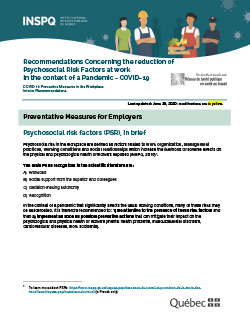Recommendations Concerning the reduction of Psychosocial Risk Factors at work in the context of a Pandemic - COVID-19
Preventative Measures for Employers
Psychosocial risk in the workplace are defined as factors related to work organization, management practices, working conditions and social relationships which increase the likelihood of adverse effects on the physical and psychological health of workers exposed (INSPQ, 2016)1.
The main PSRs recognized in the scientific literature are:
A. Workload;
B. Social support from the superior and colleagues;
C. Decision-making autonomy;
D. Recognition.
In the context of a pandemic that significantly affects the usual working conditions, many of these risks may be exacerbated. It is therefore recommended to: 1) Be attentive to the presence of these risk factors and then 2) implement as soon as possible preventive actions that can mitigate their impact on the psychological and physical health of workers (mental health problems, musculoskeletal disorders, cardiovascular diseases, work accidents).
1. Be attentive to the presence of psychosocial risk factors in the workplace
Here are a few examples of elements that contribute to creating PSRs for workers.
A. With regard to the workload, are employees, for example, subject to:
B. With regard to the social support from superiors, is the work marked by:
And is the social support from colleagues, marked by:
C. Regarding recognition, is the current work situation characterized by:
D. For decision-making autonomy, can we, for example, observe among the workers:
2. Implement as soon as possible preventive actions that can mitigate the impacts on the psychological and physical health of workers
Here are a few examples of potential actions whose positive impacts on the health of workers are widely recognized. Each environment can adapt them according to its own reality. This list is non-exhaustive and could be improved according to the specific PSRs of each workplace.
- Facilitate exchanges between immediate supervisors and workers by establishing communication methods (e.g., regular team meetings, electronic exchanges).
- Communicate regularly and transparently about the work to be done and how to do it;
- Listen to employees’ concerns and suggestions and respond to them as quickly as possible;
- Be attentive to work-life balance issues encountered by workers (childcare, teleworking).
- Strengthen the culture of support and mutual aid in the workplace.
- Leading by example;
- Encouraging empathy and goodwill within work teams;
- While respecting distancing measures or using technological tools, offer moments to allow workers to be together, to express themselves, to help each other, and to consider solutions to the challenges encountered and solutions to be developed.
- Pay attention to the conditions conducive to the emergence of psychological harassment in the workplace (e.g., unmanaged conflicts, incivilities) and initiate as soon as possible the necessary measures to prevent and as applicable, to stop them (see CNESST’s documentation on this subject: https://www.cnt.gouv.qc.ca/en/in-case-of/psychological-or-sexual-harassment/index.html).
- Equipping/having adequate means for workers to do their job well, safely and satisfactorily (e.g., telework tools, personal protective equipment, clear procedures in case of symptoms).
- Favoring recognition on a daily basis for employees and teams, valuing the efforts made by each worker making a positive assessment of work;
- Consult with employees on decisions that affect their work.
- Build on the participation of individuals and groups and stimulate initiatives.
IMPORTANT
Is this normal?
In the current context of the COVID-19 pandemic, it is normal to be concerned about one’s abilities, to have fears about the illness, feeling overwhelmed or depressed. Workers may also experience stress and anxiety.
However, some reactions may intensify and develop into psychological distress.
When to worry?
It is essential to remain attentive at all times to signs of psychological distress among workers (e.g., significant fatigue, irritability, aggressiveness, lack of concentration, difficulty assuming responsibilities or taking care of themselves or their family, significant changes in behaviour or habits, sleep disorders, suicidal thoughts, etc.).
These signs must be taken seriously. They indicate a need for help. It may be difficult for some people to ask for help, especially because of shame, fear of appearing weak or being judged. However, talking about their experience will help to break the isolation and explore new potential solutions.
Where can you find help?
To consult these resources, you can call:
- Your employee assistance program (EAP).
- Info-Social 811 (free and confidential phone consultation service that allow you to quickly reach a professional in psychosocial intervention).
- The suicide prevention hotline 1 866 APPELLE (1-866-277-3553).
Note : In order to be ready to quickly refer individuals who show signs of distress, it is recommended that a list of resources be prepared and made available.
For more information on this topic, you can refer to:
- The Ministère de la Santé et des Services sociaux (MSSS): “Stress, anxiété et déprime associés à la maladie à coronavirus COVID-19” (in French only): https://publications.msss.gouv.qc.ca/msss/fichiers/2019/19-210-14W.pdf
Some additional references on measures to implement in the context of a pandemic:
- Canadian Mental Health Association (CMHA). Published March 13, 2020. 6 tips to respond to employee anxiety about COVID-19: https://cmha.ca/news/6-tips-to-respond-to-employee-anxiety-about-covid-19
- The Institut national d’excellence en santé et services sociaux (INESSS). April, 8, 2020. COVID-19 et la détresse psychologique et la santé mentale du personnel du réseau de la santé et des services sociaux dans le contexte de l’actuelle pandémie (in French only): https://www.inesss.qc.ca/fileadmin/doc/INESSS/COVID-19/COVID-19_SM_personnel_reseau.pdf?t=1587129919074&utm_source=Openfield&utm_medium=email&utm_campaign=B2719294
- Shanafelt et al. April 7, 2020. Understanding and Addressing Sources of Anxiety Among Health Care Professionals During the COVID-19 Pandemic. JAMA : https://jamanetwork.com/journals/jama/fullarticle/2764380
1 To learn more about PSRs: https://www.inspq.qc.ca/risques-psychosociaux-du-travail-et-promotion-de-la-sante-des-travailleurs/risques-psychosociaux-du-travail (in French only).


